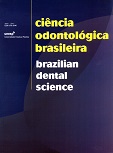The use of lasers in restorative dentistry: truths and myths
DOI:
https://doi.org/10.14295/bds.2012.v15i3.824Abstract
Researchers have been investigating the clinical applications of lasers in dentistry, which can be operated in high and low intensity. The high intensity lasers work with increasing temperature for ablation, vaporization, cutting and coagulating of the tissue while the low level lasers therapy are used in the photophysical, photobiological and photochemical effects on the cells of the irradiated tissues. This review approaches the use of lasers of high and low intensity focused in restorative dentistry. The indications for high power lasers are for dental erosion treatment, in the reconstitution of the canine guides, in the final removal of carious tissue, for dentin hypersensitivity, for microbial reduction, in the conditioning of enamel and dentin for adhesive systems and for caries prevention in pits and fissures. The low power laser can be used after cavity preparation in order to reduce post-operative sensitivity, in aesthetic procedures for maintaining periodontal health and also in the photodynamic therapy, which provides microbial reduction, combining a photosensitizing agent to a light source.
Keywords: Lasers, Dentistry, Operative, Anti-inflammatory Agents, Photodynamic therapy, Ablation techniques
Downloads
Downloads
Additional Files
Published
How to Cite
Issue
Section
License
Brazilian Dental Science uses the Creative Commons (CC-BY 4.0) license, thus preserving the integrity of articles in an open access environment. The journal allows the author to retain publishing rights without restrictions.
=================




























